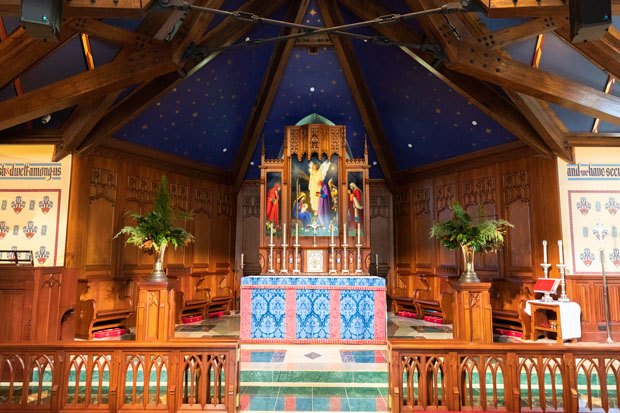Sacred Renovation
02 Feb 2023
An Historic Highlands church honors the past and makes space for the future
Story by KRISTIN LANDFIELD
Photos by DYLAN LYTLE

“Doors are important” said Reverend Bentley Manning as we stood looking at the newly renovated Episcopal Church of the Incarnation in Highlands, NC. Bentley has served as priest to the congregation since January 2018, quickly becoming a beloved figure in the town’s small community. He manifests a genuine kindness and joyful peace in every interaction. I was admiring the exquisite red doors that now signal the primary entries to the church. “Yes, as in portals!” I agreed, taking in the rich carmine lacquer and ornate iron brackets. These doors are vibrant and lavish, striking and warm. They celebrate entry into sacred space. The Church of the Incarnation’s impressive entrance conveys a powerful message: this is a point of access to a special place—indeed, a consecrated one—that invites all to approach, regardless of their doctrinal beliefs. With their beauty, the doors beckon the viewer, who when drawing closer is rewarded by the symbolic elements in the garden and interior rooms. Upon entering and proceeding deeper, the sacred art and ornament also deepen, approximating the richness and beauty of God’s love.
In that conversation, I got a clear glimpse into the profound level of consideration the church lent to each aspect of the renovation. We were standing outside in the garden (at the time a muddy construction site) talking about how sacred spaces offer experience in which physical objects reveal essential meaning, recognizing that such spaces may be sentient “doorways” into spiritual awareness. Theologically, Christianity holds that beauty is a divine attribute, central to understanding aesthetics and what is “good.” Sacred architecture and art convey the glory of the Divine, aiming to use material objects of wood and stone to express ineffable spiritual realities.
Historically, houses of worship were the chief public repository for art and literature. They were extraordinary spaces that elevated the community. In classic Greek, the term temenos (deriving from the verb “I cut”) denotes pieces of land demarcated for special use, often enclosing a place of worship. Crossing into a temenos offered sanctuary and protection under the deity. Broadly speaking, holy places are set aside and reserved as designated spaces to seek transcendence and reprieve from the trials of life, as displayed in all major world religions (e.g., Kanchipuram Temples in South India, carved Buddhist shrines, brilliant Islamic mosaics, among countless others). Bentley noted that parks, museums, monuments, etc. all share characteristics as public space, but a church is a particular kind of space. It's a place to grieve, to celebrate, to say that we’re sorry and to give thanks—the most beautiful measures in a human life. Creating the right kind of space facilitates and sanctifies those essential acts.
Those of us who love this spectacular region of the Highlands-Cashiers Plateau are familiar with the transcendence natural beauty can offer—places that are sacred and thereby arouse in us a sense of awe, humility, wonder. A goal for sacred space in built environments is similar: to awaken and inspire a sublime sense of the Divine. Such holy spaces, throughout all spiritual traditions, are meant to pull the individual from the meaner and wearisome aspects of earthly existence and so dignify the human spirit with a glimpse of the heavens. The metaphor is that by entering into the holy space, one is entering into a relationship. As one goes deeper and draws nearer, the relationship deepens in meaning and intimacy.
The Episcopal Church believes that through the Incarnation, God has chosen physical closeness to humanity. Along with the beautiful altarpiece and detailed artwork, words from the Prologue to John’s Gospel wrap the sanctuary. Bentley explained that John’s Gospel contains what the church believes is the fullness of God’s dealings with humanity: “And the Word became flesh and dwelt among us, and we saw His glory.” By wrapping the walls with this text, they seek to wrap the congregation with the comfort of this teaching. This feature is one among dozens of details intended to enhance the spiritual experience of those who enter. In the 12th century A.D., Saint Anselm prayed, “Lord … Raise me up from myself and draw me to you … for you are life and wisdom, truth and beauty, and everything that is good." Herein lies the hope for a house of worship: creating the right milieu for transcendence, which was at the heart of the church’s impressive undertaking.
A generous gift initiated the vision for the project, allowing the church to retain Cram and Ferguson, a renowned ecclesiastical architecture firm from Boston. The architects inspired the church to “imagine ourselves part of something greater, to embrace more fully the beauty and aesthetic of our rich Anglican tradition. Through this enhanced sacramental space of worship, we aspire to unite our parish to be the hands and feet of Christ in our community and beyond.” The goals for the ambitious renovation project were made explicit: illuminate, invite and inspire.
Built in 1896, the historic church had grown in recent decades, such that there was no longer a clear point of entry. Now the main doors open immediately off the sidewalk on Main Street, and the matching ones at the original chapel and on 5th street are more legible to visitors. The original chapel connects to the sanctuary via an open glass corridor, allowing light to shine in from the sun - and light to shine out from the church into the community. It was essential that the new architecture honor and enhance the already beautiful Carpenter Gothic structure that has been an important part of Highlands for 127 years. The improved accessibility of the church communicates a fervent desire to share.
A guiding principle for the chosen symbolism and iconography was to represent God’s creation. This church, a beautiful example of Anglican aesthetics, is situated within a region of uncommon natural beauty, so the ornament is reflective of the unique surrounds. As one draws nearer to the paintings and stained glass, distinctive details emerge to indicate a sense of place: small animals and insects are positioned among vegetation that represents the glory of the plateau.
This renovation wasn’t limited to the wood and stone of the structure. Rebuilding a lovely garden was vital to the project. This church has always tended a charming garden—one that celebrates the distinct joy and beauty plants bring to our lives in both tangible and metaphorical ways, one that is a garden of the heart. The hope was that an exuberant garden would further welcome those who draw near, present a sense of delight, engage the senses, and create appealing moments for contemplation throughout the changing seasons.
The vestry engaged Alex Smith Garden Design, Ltd. to develop and implement this vision, yielding a layered and vibrant space that calls out to passersby. The garden includes old-fashioned phlox, daisies and roses, forget-me-nots and delphinium, a gurgling fountain visible from many vantage points, and a repurposed statue of Saint Fiacre, all of which communicate the joyful spirit of the congregation. Bentley’s favorite is a cultivar of Halesia, the Carolina Silverbell, with dark foliage and a blush-pink flower that splendidly contrasts against the white walls of the exterior.
Above the iconic doors, in large clear lettering, reads, “God, My Heart Is Ready”—such straightforward expression of the essence of Christian devotion. In this special project, heartfulness converged with care, tradition, authentic vernacular and craftsmanship to create a sacred space, a vessel formed to uplift and nourish the treasured community. It’s been a distinct pleasure to see the ambitious undertaking come to life, enriching the spirits of those who draw near.














